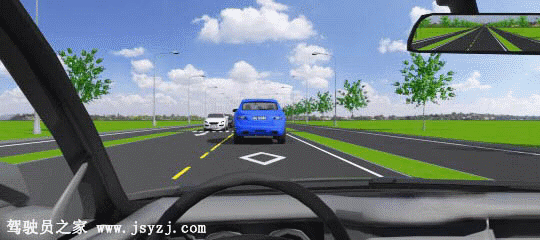1、Drivers should drive at a lower speed when traffic police give these hand signals.

A、Right
B、Wrong
Answer:A
2、When a bicycle occupies the motor vehicle lane and obstructs the traffic, the driver should sound the horncontinuously and speed up to bypass on the left of the bicycle.
A、Right
B、Wrong
Answer:B
3、What should the driver do when the motor vehicle passes a flyover?

A、Speed up and pass rapidly
B、Keep the speed under 15 km/hour
C、Drive at the speed indicated by the traffic sign
D、Drive close to the central line of the flyover
Answer:C
4、The sign on the right indicates that the vehicle should yield to the oncoming traffic as approaching each other.

A、Right
B、Wrong
Answer:B
5、What should the driver do if he/she wants to turn right at this intersection?

A、Turn right along the straight-going lane
B、Wait behind the stop line
C、Turn right along the right lane
D、Borrow the non-motor vehicle lane and turn right
Answer:C
6、As shown in this picture, the intersection guide line is designed to help drivers make turns.

A、Right
B、Wrong
Answer:A
7、The sign in front indicates a one-way lane after turning left.

A、Right
B、Wrong
Answer:A
8、The sign on the right indicates a one-kilometer distance from ETC toll station ahead.

A、Right
B、Wrong
Answer:B
9、What should drivers do when encountering a rainstorm on a common road and the windscreen-wiper fails to make sight clear?
A、Drive at a reduced speed
B、Drive carefully
C、Cut speed in time and pull over
D、Drive at a normal speed
Answer:C
10、As shown in the flash, what should the driver do when the motor vehicle encounters this situation?

A、Speed up and pass rapidl
B、Stop immediately
C、Sound the horn to indicate the pedestrians to yield
D、Observe the movement of pedestrians and non-motor vehicles before passing
Answer:D
11、What's the most frequent problem for driving on a muddy road?
A、High resistance force
B、Sideways slide
C、The motor vehicle bumps
D、Steering failure
Answer:B
12、The sign indicates no overtaking on the section ahead.

A、Right
B、Wrong
Answer:B
13、When rescuing a wounded person who has been poisoned by toxic gas, the first measure is to send him/her to a place with fresh air so that he/she will not continue to be poisoned.
A、Right
B、Wrong
Answer:A
14、The sign on the right is an advance announcement of the highway destination.

A、Right
B、Wrong
Answer:B
15、When a motor vehicle reaches a muddy or burst-and-muddy section of the road, the driver should stop, observe and select a level and solid section or a section with vehicle tracks.
A、Right
B、Wrong
Answer:A
16、When driving on a road covered with ice and snow, the motor vehicle may spin or slide when increasing the speed urgently, due to the loss of vehicle stability.
A、Right
B、Wrong
Answer:A
17、The sign in front indicates the name and number of the highway.

A、Right
B、Wrong
Answer:A
18、When a motor vehicle breaks down and has to be stopped on the highway, what should the driver do?
A、Set up a breakdown warning sign 150 meters behind the vehicle
B、Set up a breakdown warning sign 100 meters behind the vehicle
C、If it happens at night, turn on the clearance lamp and rear position lamp
D、Turn on the hazard lamps
Answer:ACD
19、Dangerous chemicals possess the characteristics of explosion, inflammation, poison, erosion and radiation.
A、Right
B、Wrong
Answer:A
20、Mr. Qian drove a large sleeper coach with 45 passengers (capacity 40 people) at a speed of more than 40 kilometers per hour. On a long slope with sharp curves in Basu County, the coach fell into a 100-meter-deep valley, killing 17 people and injuring 20. What's the main illegal act committed by MrQian?
A、Making a cellphone call while driving
B、Speeding
C、Carrying more people than permitted
D、Fatigued driving
Answer:BC